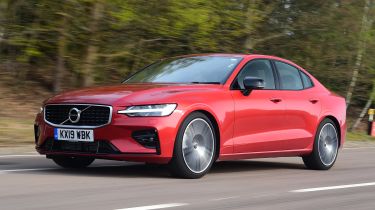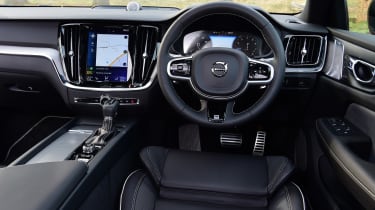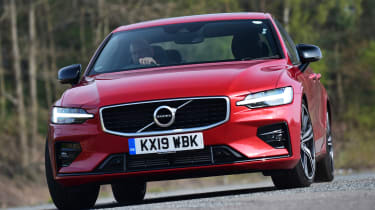New Volvo S60 2019 review
The new Volvo S60 arrives as a rival for the BMW 3 Series and Jaguar XE, but how does it compare on British roads?
This new Volvo S60 doesn’t know quite what it wants to be. Is it a sporty saloon with a powerful petrol engine or a comfortable cruiser? It tries to be both, but stalls at those tasks thanks to a dull engine and harsh ride. It has plenty of potential thanks to the high-quality interior and excellent refinement, but this launch model isn’t as good as it could be.
The highly competitive and hugely desirable compact executive class is moving on, following a stagnant few years in which no new models were launched.
Over the past six months or so we’ve seen a brand-new BMW 3 Series, as well as updated versions of the Jaguar XE and Mercedes C-Class. A heavily revised Audi A4 is just around the corner, too, and the latest arrival is this: the all-new Volvo S60.
The estate-bodied V60 has been around long enough for us to run one on our test fleet, covering around 8,000 miles in just six months. So we did have some idea what to expect from this new S60 saloon. That’s no bad thing, though, as we were thoroughly impressed with our diesel V60’s refinement and usability.
As you might expect, the S60 delivers in those areas, too. Wind and road noise are hushed even at motorway speeds, and engine noise is very well isolated. But Volvo doesn’t plan to add any diesel engines to the range, and there’s only one petrol available at the moment (the 247bhp 2.0-litre T5 tested here), which comes mated to an eight-speed automatic box as standard. There’s also only one trim to pick from, the R-Design Edition, which means your choices are pretty limited to begin with.
More reviews
Car group tests
In-depth reviews
Long-term tests
Road tests
- New Volvo S60 Polestar Engineered 2019 review
- New Volvo S60 T5 Inscription Plus 2019 review
- New Geometry A 2019 review
Used car tests
The engine isn’t bad; it’s quiet, and we managed economy towards the top end of the official claimed range of 35.3-39.8mpg. But it’s just not that easy to recommend.
Despite having nearly 250bhp, it doesn’t feel sporty or exciting; put your foot down and there’s a muted growl and a surge of torque from low in the rev range, but it starts to sound harsh and thrashy at higher revs. If you let the gearbox do all the work, it will allow the engine to build speed. However, if you take over, using the paddles behind the steering wheel, you’ll find that the gearbox is a little bit slow to respond.
It’s certainly a contrast to the sportier cars in this class, such as the 3 Series, XE or Alfa Romeo Giulia; and yet, with a powerful petrol engine under the bonnet, it invites the comparison despite an obvious focus on comfort and refinement inside.
A diesel engine, like the 148bhp D3 we ran in our V60, or a less powerful petrol would make more sense in the hushed S60. But the good news is that a selection of plug-in hybrid versions is on the way, and these are likely to be a better fit for private buyers and company car drivers alike.
That’s especially true when you consider this car’s CO2 emissions and associated Benefit-in-Kind (BiK) tax rating. By emitting 155g/km, this S60 T5 sits in the lofty 35 per cent bracket – just two points from the top.
A new 330i M Sport emits just 134g/km, placing it five bands lower. Higher-mileage motorists should note that a diesel 3 Series can emit as little 112g/km, so even with the four per cent surcharge, the 320d’s BiK rating is identical to its petrol sibling’s.
Elsewhere, although the S60 R-Design Edition has 19-inch wheels as standard, our test car was fitted with optional 20-inch rims, so the ride wasn’t perfect. It was nice and smooth on motorways and A-roads, but rather more uncomfortable anywhere with potholes or small bumps. Despite the S60 controlling body roll pretty well, and having plenty of grip, it can’t prevent harsh bumps from being transmitted into the cabin. The 3 Series is much more compliant, as well as being significantly more agile.
The basic message here is that the S60 isn’t as good to drive nor as comfortable as some of its key rivals, but it’s not as far wide of the mark as it might seem. For a start, the Volvo’s interior is among the best in class, with a simple yet elegant design and high-quality materials used throughout.
It makes the larger S90 look expensive, in fact, because it’s very similarly trimmed inside – but for a much lower asking price. The fully digital dials and crisp infotainment follow this line, too, as the set-up is one of the best in the business, thanks to a sharp and responsive touchscreen display.
However – and this is a problem in all modern Volvos – the screen-operated air-con means it’s a pain to change the fan speed or temperature while driving, as you have to look down to see what you’re doing.
On the other hand, the light steering means it’s easy to drive, and the bumpy ride is somewhat mitigated by the superb seats. There’s lots of legroom in the back as well, although the £1,200 optional panoramic sunroof does eat into headroom slightly.







